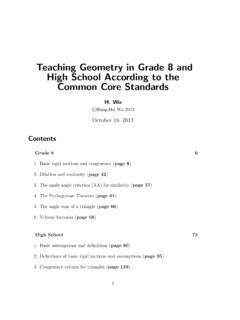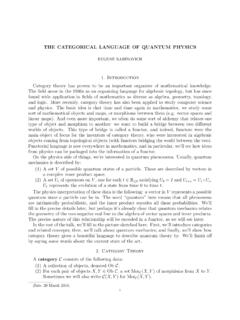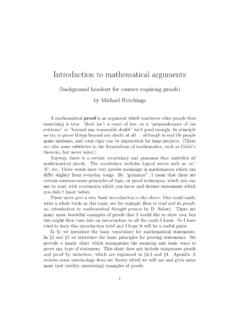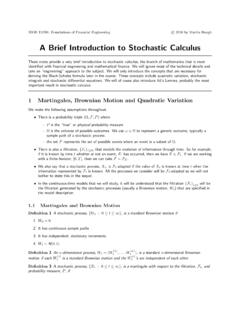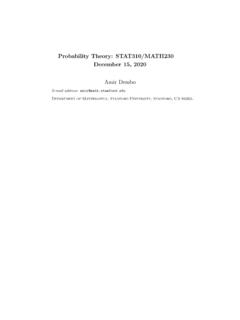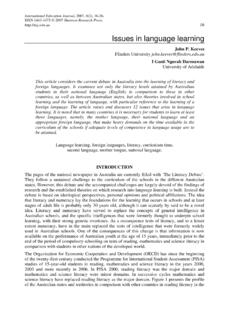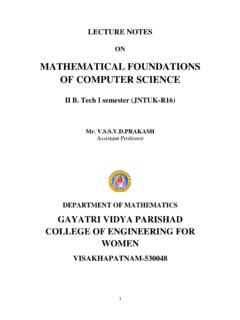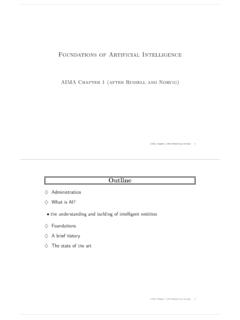Transcription of The Foundations of Geometry - University of California ...
1 TheFoundations of GeometryBYDAVID HILBERT, PH. OF MATHEMATICS, University OF G TTINGENAUTHORIZED TRANSLATIONBYE. J. TOWNSEND, PH. OF ILLINOISREPRINT EDITIONTHE OPEN COURT PUBLISHING COMPANYLA SALLEILLINOIS1950 TRANSLATION material contained in the following translation was given in substance by Professor Hilbertas a course of lectures on euclidean Geometry at the University of G ttingen during the wintersemester of1898 1899. The results of his investigation were re-arranged and put into the formin which they appear here as a memorial address published in connection with the celebrationat the unveiling of the Gauss-Weber monument at G ttingen, in June,1899.
2 In the Frenchedition, which appeared soon after, Professor Hilbert made some additions, particularly in theconcluding remarks, where he gave an account of the results of a recent investigation made byDr. Dehn. These additions have been incorporated in the following a basis for the analysis of our intuition of space, Professor Hilbert commences his discus-sion by considering three systems of things which he calls points, straight lines, and planes, andsets up a system of axioms connecting these elements in their mutual relations.
3 The purposeof his investigations is to discuss systematically the relations of these axioms to one anotherand also the bearing of each upon the logical development of euclidean Geometry . Among theimportant results obtained, the following are worthy of special mention:1. The mutual independence and also the compatibility of the given system of axioms isfully discussed by the aid of various new systems of Geometry which are The most important propositions of euclidean Geometry are demonstrated in such amanner as to show precisely what axioms underlie and make possible the The axioms of congruence are introduced and made the basis of the definition of The significance of several of the most important axioms and theorems in the develop-ment of the euclidean Geometry is
4 Clearly shown; for example, it is shown that the whole of theeuclidean Geometry may be developed without the use of the axiom of continuity; the signifi-cance of Desargues s theorem, as a condition that a given plane Geometry may be regarded as apart of a Geometry of space, is made apparent, A variety of algebras of segments are introduced in accordance with the laws of development and discussion of the foundation principles of Geometry is not only ofmathematical but of pedagogical importance. Hoping that through an English edition theseimportant results of Professor Hilbert s investigation may be made more accessible to Englishspeaking students and teachers of Geometry , I have undertaken, with his permission, this trans-lation.
5 In its preparation, I have had the assistance of many valuable suggestions from ProfessorOsgood of Harvard, Professor Moore of Chicago, and Professor Halsted of Texas. I am alsounder obligations to Mr. Henry Coar and Mr. Arthur Bell for reading the J. TownsendUniversity ..1 CHAPTER FIVE GROUPS OF AXIOMS. 1. The elements of Geometry and the five groups of axioms ..2 2. Group I: Axioms of connection ..2 3. Group II: Axioms of Order ..3 4. Consequences of the axioms of connection and order ..5 5. Group III: Axiom of Parallels (Euclid s axiom).
6 7 6. Group IV: Axioms of congruence ..8 7. Consequences of the axioms of congruence ..10 8. Group V: Axiom of Continuity (Archimedes s axiom) ..15 CHAPTER COMPATIBILITY AND MUTUAL INDEPENDENCE OF THE AXIOMS. 9. Compatibility of the axioms ..17 10. Independence of the axioms of parallels. Non-euclidean Geometry ..19 11. Independence of the axioms of congruence ..20 12. Independence of the axiom of continuity. Non-archimedean geometry21 CHAPTER THEORY OF PROPORTION. 13. Complex number-systems ..23 14.
7 Demonstration of Pascal s theorem ..25 15. An algebra of segments, based upon Pascal s theorem ..30 16. Proportion and the theorems of similitude ..33 17. Equations of straight lines and of planes ..35 CHAPTER THEORY OF PLANE AREAS. 18. Equal area and equal content of polygons ..38 19. Parallelograms and triangles having equal bases and equal altitudes .40 20. The measure of area of triangles and polygons ..41 21. Equality of content and the measure of area ..44 CHAPTER S THEOREM. 22. Desargues s theorem and its demonstration for plane geometryby aid of the axioms of congruence.
8 48 23. The impossibility of demonstrating Desargues s theorem for theplane without the help of the axioms of congruence ..50 24. Introduction of an algebra of segments based upon Desargues s theoremand independent of the axioms of congruence ..53 25. The commutative and the associative law of addition for our newalgebra of segments ..55 26. The associative law of multiplication and the two distributive lawsfor the new algebra of segments ..56 27. Equation of the straight line, based upon the new algebra of segments.
9 61 28. The totality of segments, regarded as a complex number system ..64 29. Construction of a Geometry of space by aid of adesarguesian number system ..65 30. Significance of Desargues s theorem ..67 CHAPTER S THEOREM. 31. Two theorems concerning the possibility of proving Pascal s theorem ..68 32. The commutative law of multiplication for anarchimedean number system ..68 33. The commutative law of multiplication for anon-archimedean number system ..70 34. Proof of the two propositions concerning Pascal s Geometry .
10 72 35. The demonstration, by means of the theorems of Pascal and Desargues,of any theorem relating to points of intersection ..73 CHAPTER CONSTRUCTIONS BASED UPON THE AXIOMS I V. 36. Geometrical constructions by means of a straight-edge and atransferer of segments ..74 37. Analytical representation of the co-ordinates of pointswhich can be so constructed ..76 38. The representation of algebraic numbers and of integral rational functionsas sums of squares ..78 39. Criterion for the possibility of a geometrical construction by means ofa straight-edge and a transferer of segments.
